This topic gives you step-by-step instructions on how to make your email messages accessible and unlock your content to everyone, including people with disabilities.
You learn, for example, how to work with the Accessibility Checker to tackle accessibility issues while you're writing your email message. You'll also learn how to add alt texts to images so that people using screen readers are able to listen to what the image is all about. You can also read about how to use fonts, colors, and styles to maximize the inclusiveness of your email messages before sending them.
In this topic
Check accessibility while you work in Outlook
The Accessibility Checker is a tool that reviews your content and flags accessibility issues it comes across. It explains why each issue might be a potential problem for someone with a disability. The Accessibility Checker also suggests how you can resolve the issues that appear.
In Outlook, the Accessibility Checker runs automatically in the background when you're composing an email. If the Accessibility Checker detects accessibility issues, a MailTip will provide a convenient nudge to review and correct the issues before sending your email.


In Outlook, you can define how the accessibility notifications and Accessibility Checker work. Select File > Options > Accessibility and select if you want to see accessibility notifications through a MailTip while you work, in certain scenarios, or only when you manually launch the Accessibility Checker.
The default option is to show accessibility notifications in certain scenarios. If any accessibility issues are detected, a MailTip appears to guide you to review suggestions and fix the issue.
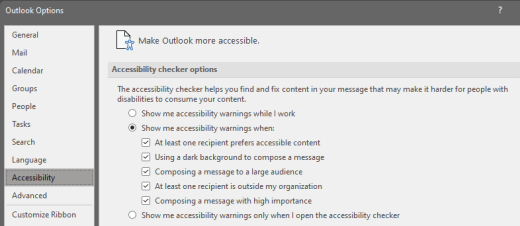
The following options are available:
-
Show me accessibility warnings while I work
-
Show me accessibility warnings when:
-
At least one recipient prefers accessible content
-
Using a dark background to compose a message. If you're composing in Black Theme with dark mode enabled, which is the default for this theme, the Accessibility Checker runs but shows notifications only when text contrast is insufficient. Any other issues will still appear in the Accessibility pane, but they won't cause the MailTip to appear.
-
Composing a message to a large audience
-
At least one recipient is outside my organization
-
Composing a message with high importance
-
-
Show me accessibility warnings only when I open the accessibility checker
To manually launch the Accessibility Checker, select Review > Check Accessibility. The Accessibility pane opens, and you can now review and fix accessibility issues. For more info, go to Improve accessibility with the Accessibility Checker.
Avoid using tables
In general, avoid tables if possible and present the data another way, like paragraphs with headings and banners. Tables with fixed width might prove difficult to read for people who use Magnifier, because such tables force the content to a specific size. This makes the font very small, which forces Magnifier users to scroll horizontally especially on mobile devices.
If you have to use tables, use the following guidelines to make sure your table is as accessible as possible:
-
Avoid fixed width tables.
-
Make sure the tables render properly on all devices, including phones and tablets.
-
If you have hyperlinks in your table, edit the link texts, so they make sense and don't break mid-sentence.
-
Make sure the email is easily read with Magnifier. Send the email draft to yourself and view it on a mobile device to make sure people won’t need to horizontally scroll the email on a phone, for example.
Use table headers
Screen readers keep track of their location in a table by counting table cells. If a table is nested within another table or if a cell is merged or split, the screen reader loses count and can’t provide helpful information about the table after that point. Blank cells in a table could also mislead someone using a screen reader into thinking that there is nothing more in the table. Use a simple table structure for data only and specify column header information. Screen readers also use header information to identify rows and columns.
To ensure that tables don't contain split cells, merged cells, or nested tables, use the Accessibility Checker.
-
Place the cursor anywhere in a table.
-
On the Table Design tab, in the Table Style Options group, select the Header Row checkbox.
-
Type your column headings.

Use built-in headings and styles
Headings are meant to be scanned, both visually and with assistive technology. Ideally, headings explain what an email section is about. Use the built-in heading styles and create descriptive heading texts to make it easier for screen reader users to determine the structure of the message and navigate the headings.
Organize headings in the prescribed logical order. For example, use Heading 1 and then Heading 2. Organize the information in your email into small chunks. Ideally, each heading would include only a few paragraphs.
For the step-by-step instructions on how to use the headings and styles, go to Format email messages with Styles.
Create paragraph banners
In addition to using headings to organize the content in your email message, you can also create paragraph banners. In a paragraph banner, the background color block extends across the width of the email message and highlights the text within the banner. This is a great alternative to tables to organize and separate content.
-
Select your banner text.
-
Select the Format Text tab.
-
In the Paragraph group, select

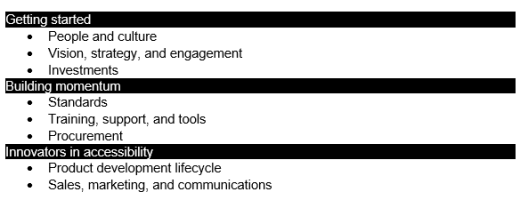
Add alt text to visuals
Alt text helps people who can’t see the screen to understand what’s important in images, shapes, SmartArt graphics, charts, and other visuals. In alt text, briefly describe the image and mention its intent. Screen readers read the text to describe the image to users who can’t see the image.
For the step-by-step instructions on how to add alt text, go to Add alternative text to a shape, picture, chart, SmartArt graphic, or other object.
For more info on how to write alt text, go to Everything you need to know to write effective alt text. Visual content includes pictures, SmartArt graphics, shapes, groups, charts, embedded objects, ink, and videos.
To find missing alternative text, use the Accessibility Checker.
Notes:
-
For audio and video content, in addition to alt text, include closed captioning for people who are deaf or hard of hearing.
-
Avoid using text in images as the sole method of conveying important information. If you must use an image with text in it, repeat that text in the email message.
Add accessible hyperlink text and ScreenTips
People who use screen readers sometimes scan a list of links. Links should convey clear and accurate information about the destination. For example, avoid using link texts such as "Click here," "See this page," "Go here," or "Learn more." Instead include the full title of the destination page. You can also add ScreenTips that appear when your cursor hovers over text or images that include a hyperlink.
Tip: If the title on the hyperlink's destination page gives an accurate summary of what’s on the page, use it for the hyperlink text. For example, this hyperlink text matches the title on the destination page: Create more with Microsoft templates.
For the step-by-step instructions on how to create hyperlinks and ScreenTips, go to Create or edit a hyperlink.
Use accessible font format and color
An accessible font doesn't exclude or slow down the reading speed of anyone reading an email message, including people with low vision or reading disability or people who are blind. The right font improves the legibility and readability of the email messages.
For instructions on how to change the default font, go to Change or set the default font in Outlook.
Use accessible font format
To reduce the reading load, select familiar sans serif fonts such as Arial or Calibri. Avoid using all capital letters and excessive italics or underlines.
A person with a vision disability might miss out on the meaning conveyed by particular colors. For example, add an underline to color-coded hyperlink text so that people who are colorblind know that the text is linked even if they can’t see the color. For headings, consider adding bold or using a larger font.
-
Select your text.
-
Select the Format Text tab.
-
In the Font group, which provides options for font type, size, style, and color, select your formatting choices.
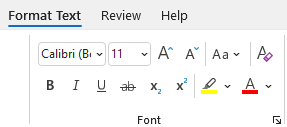
Use accessible font color
The text in your email should be readable in a high contrast mode. For example, use bright colors or high-contrast color schemes on opposite ends of the color spectrum. White and black schemes make it easier for people who are colorblind to distinguish text and shapes.
To ensure that text displays well in a high contrast mode, use the Automatic setting for font colors. To find insufficient color contrast, use the Accessibility Checker.
-
Select your text.
-
Select Message.
-
In the Font group, select

-
Select Automatic.
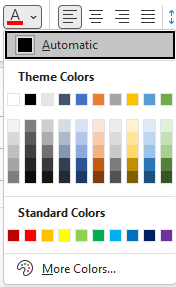
Create accessible lists
To make it easier for screen readers to read your email, organize the information in your email into small chunks such as bulleted or numbered lists.
For the step-by-step instructions on how to create lists, go to Add a numbered or bulleted list to a message.
Adjust space between sentences and paragraphs
People who have dyslexia describe seeing text “swim together” on a page (the compressing of one line of text into the line below). They often see text merge or distort. To reduce the reading load, you can increase white space between sentences and paragraphs.
-
Select your text.
-
Select the Format Text tab.
-
In the Paragraph group, in the lower-right corner of the group, select the dialog box launcher button to expand the group. The Paragraph dialog box opens, showing the Indents and Spacing tab.

-
Under Spacing, select the spacing options you want and then select OK.
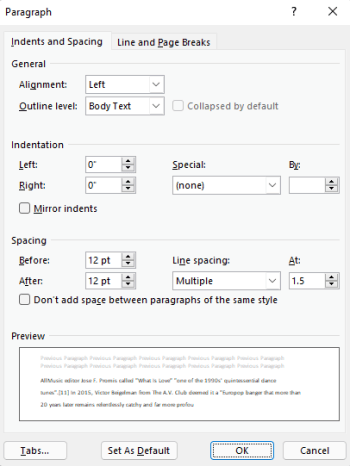
Request accessible email
Let people who send you email know that you prefer to receive accessible content.
-
To go to your account details on the web, in Outlook, select File > Info, and then in Account Settings, click the link under Access this account on the web. Outlook on the web opens in your browser.
-
In Outlook on the web, to go to Accessibility Settings, select

-
To request accessible content, select the Ask senders to send content that’s accessible checkbox. Then close the Settings window.
Test accessibility with Immersive Reader
Try reading the email with Immersive Reader to check how it sounds like.
-
In your email message, select Message > Immersive Reader.
-
On the Immersive Reader tab, select Read Aloud.
-
To exit Immersive Reader, select Close Immersive Reader.
See also
Video: Improve email accessibility
Improve accessibility with the Accessibility Checker
Rules for the Accessibility Checker
Make your Word documents accessible to people with disabilities
Make your Excel documents accessible to people with disabilities
Make your PowerPoint presentations accessible to people with disabilities
In this topic
Best practices for making Outlook email accessible
The following table includes key best practices for creating Outlook email that is accessible to people with disabilities.
|
What to fix |
Why fix it |
How to fix it |
|---|---|---|
|
Avoid common accessibility issues such as missing alternative text (alt text) and low contrast colors. |
Make it easy for everyone to read your Outlook email. |
|
|
If you must use tables, create a simple table structure for data only, and specify column header information. |
Screen readers keep track of their location in a table by counting table cells. Screen readers also use header information to identify rows and columns. |
|
|
Include alternative text with all visuals. |
Alternative text helps people who can’t see the screen to understand what’s important in images and other visuals. |
|
|
Add meaningful hyperlink text and ScreenTips. |
People who use screen readers sometimes scan a list of links. |
|
|
Use sufficient contrast for text and background colors. |
Strong contrast between text and background makes it easier for people with low vision or colorblindness to see and use the content. |
|
|
Ensure that color is not the only means of conveying information. |
People who are blind, have low vision, or are colorblind might miss out on the meaning conveyed by particular colors. |
|
|
Use font formatting and built-in lists. |
Organize and structure the information in your email into small units which are easy to read, navigate, and skim through. |
|
|
Use a larger font size (11pt or larger), sans serif fonts, and sufficient white space. |
To reduce reading load, use familiar sans serif fonts, such as Arial or Calibri. People with dyslexia perceive text in a way that can make it difficult to distinguish letters and words. |
Check accessibility while you work in Outlook
The Accessibility Checker is a tool that reviews your content and flags accessibility issues it comes across. It explains why each issue might be a potential problem for someone with a disability. The Accessibility Checker also suggests how you can resolve the issues that appear.
In Outlook, the Accessibility Checker runs automatically in the background when you're composing an email.
-
In Outlook, while writing or replying to an email message, select Check Accessibility. If you don't see the button on the toolbar, you need to add it there manually. Select (See more items) > Customize toolbar. Then drag and drop the Check Accessibility button to the toolbar.
Tip: In Outlook, you can also access the Accessibility Checker from a MailTip at the top of the message window. The accessibility MailTip appears if one of your message recipients has set up a preference for receiving accessible email.
The Accessibility pane opens. It lists accessibility issues organized into warnings, errors, and tips. For more information on the categorization, go to Rules for the Accessibility Checker.
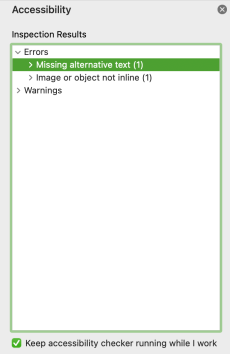
-
To review and resolve the findings, select a category and an issue. Under the selected issue, you'll find all items and objects affected by the issue. Select an item or object to see why you should fix the issue and steps to take to change the content.
Avoid using tables
In general, avoid tables if possible and present the data another way, like paragraphs with headings and banners. Tables with fixed width might prove difficult to read for people who use Magnifier, because such tables force the content to a specific size. This makes the font very small, which forces Magnifier users to scroll horizontally especially on mobile devices.
If you have to use tables, use the following guidelines to make sure your table is as accessible as possible:
-
Avoid fixed width tables.
-
Make sure the tables render properly on all devices, including phones and tablets.
-
If you have hyperlinks in your table, edit the link texts, so they make sense and don't break mid-sentence.
-
Make sure the email is easily read with Magnifier. Send the email draft to yourself and view it on a mobile device to make sure people won’t need to horizontally scroll the email on a phone, for example.
Use table headers
Screen readers keep track of their location in a table by counting table cells. If a table is nested within another table or if a cell is merged or split, the screen reader loses count and can’t provide helpful information about the table after that point. Blank cells in a table could also mislead someone using a screen reader into thinking that there is nothing more in the table. Use a simple table structure for data only and specify column header information. Screen readers also use header information to identify rows and columns.
To ensure that tables don't contain split cells, merged cells, or nested tables, use the Accessibility Checker.
To specify a header row in a table:
-
Position the cursor anywhere in a table.
-
On the Table Design tab, select the Header Row checkbox.
-
Type column headings.

Add alt text to visuals
Alt text helps people who can’t see the screen to understand what’s important in images and other visuals. Screen readers read the text to describe the image to users who can’t see the image. When writing alt text, briefly describe the image and mention its intent.
For the step-by-step instructions on how to add alt text to visuals, go to Add alternative text to a shape, picture, chart, SmartArt graphic, or other object.
For more info on how to write alt text, go to Everything you need to know to write effective alt text. Visual content includes pictures, SmartArt graphics, shapes, groups, charts, embedded objects, ink, and videos.
To find missing alternative text, use the Accessibility Checker.
Notes:
-
For audio and video content, in addition to alt text, include closed captioning for people who are deaf or hard of hearing.
-
Avoid using text in images as the sole method of conveying important information. If you must use an image with text in it, repeat that text in the email message.
Add accessible hyperlink text and ScreenTips
People who use screen readers sometimes scan a list of links. Links should convey clear and accurate information about the destination. For example, avoid using link texts such as "Click here," "See this page," Go here," or "Learn more." Instead include the full title of the destination page. You can also add ScreenTips that appear when your cursor hovers over text or images that include a hyperlink.
-
Select the text to which you want to add the hyperlink, right-click the text, and then select Link. The text you selected displays in the Text to Display box. This is the hyperlink text.
-
If necessary, change the hyperlink text.
-
In the Address box, type the destination URL.
-
Select the ScreenTip button and, in the ScreenTip text box, type a ScreenTip.
Tip: If the title on the hyperlink's destination page gives an accurate summary of what’s on the page, use it for the hyperlink text. For example, this hyperlink text matches the title on the destination page: Create more with Microsoft templates.
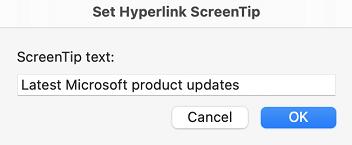
Use accessible font format
An accessible font doesn't exclude or slow down the reading speed of anyone reading an email message, including people with low vision or reading disability or people who are blind. The right font improves the legibility and readability of the email messages.
Select familiar sans serif fonts such as Arial or Calibri. Avoid using all capital letters and excessive italics or underlines.
People who are blind, have low vision, or are colorblind might miss out on the meaning conveyed by particular colors. For example, add an underline to color-coded hyperlink text so that people who are colorblind know that the text is linked even if they can’t see the color. For headings, consider adding bold or using a larger font.
-
Select your text.
-
In the format ribbon, which provides options for font type, size, style, and color, select your formatting choices.

Use accessible font color
The text in your email should be readable in high contrast mode so that everyone, including people with visual disabilities, can see it well.
For example, use bright colors or high-contrast color schemes on opposite ends of the color spectrum. White and black schemes can help people who are colorblind distinguish between colors.
To find insufficient color contrast, use the Accessibility Checker.
To ensure that text displays well in high contrast mode, use the Automatic setting for font colors.
-
Select your text.
-
Select Message > Font Color.
-
Select Automatic.
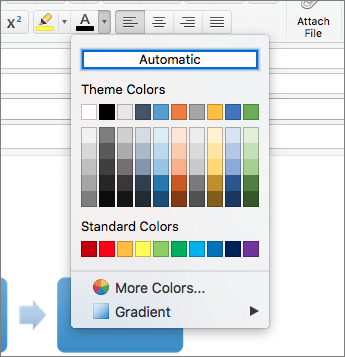
Create accessible lists
To make it easier for screen readers to read your email, organize the information in your email into small chunks such as bulleted or ordered lists.
Use bulleted lists
Create bulleted lists by using the Bullets button.
-
Position the cursor anywhere in your email.
-
Select the Message tab.
-
In the Paragraph group, select the Bullets button.
-
Type each bullet item in the bulleted list.
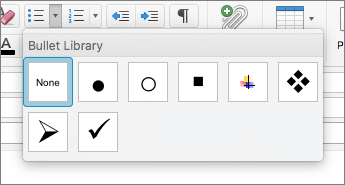
Use numbered lists
Create a numbered list by using the Numbering button.
-
Position the cursor anywhere in your email.
-
Select the Message tab.
-
In the Paragraph group, select the Numbering button.
-
Type each step in the numbered list.
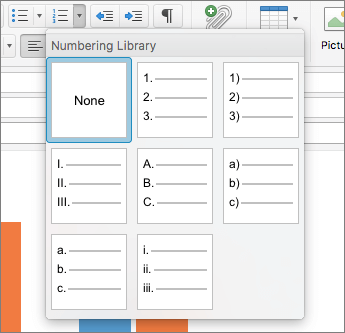
Adjust space between sentences and paragraphs
People who have dyslexia describe seeing text “swim together” on a page (the compressing of one line of text into the line below). They often see text merge or distort.
To reduce the reading load, you can increase white space between sentences and paragraphs.
-
Select your text, right-click it, and then select Paragraph.
The Paragraph dialog box opens, showing the Indents and Spacing tab.
-
Under Spacing, select the spacing options you want, and then press OK.
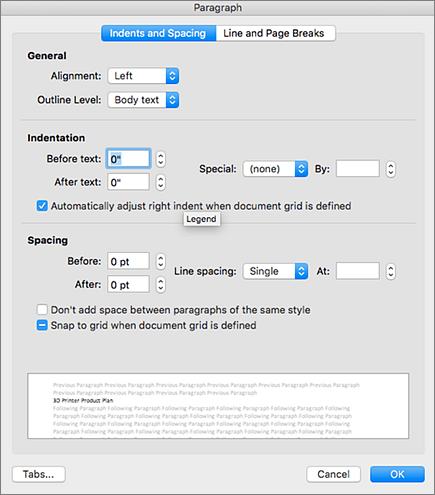
See also
Improve accessibility with the Accessibility Checker
Rules for the Accessibility Checker
Make your Word documents accessible to people with disabilities
Make your Excel documents accessible to people with disabilities
Make your PowerPoint presentations accessible to people with disabilities
In this topic
Best practices for making Outlook email accessible
The following table includes key best practices for creating an Outlook for iOS email that is accessible to people with disabilities.
|
What to fix |
Why fix it |
How to fix it |
|---|---|---|
|
Include alternative text with visuals. |
Alternative text helps people who can’t see the screen to understand what’s important in images and other visuals. |
|
|
Add meaningful hyperlink text. |
People who use screen readers sometimes scan a list of links. |
|
|
Use built-in lists. |
Organize and structure the information in your email into small units which are easy to read, navigate, and skim through. |
Add alternative text to visuals
Alt text helps people who can’t see the screen to understand what’s important in images, shapes, SmartArt graphics, charts, and other visuals. In alt text, briefly describe the image and mention its intent. Screen readers read the text to describe the image to users who can’t see the image.
Avoid using text in images as the sole method of conveying important information. If you must use an image with text in it, repeat that text in the email message.
To write a good alt text, make sure to convey the content and the purpose of the image in a concise and unambiguous manner. The alt text shouldn’t be longer than a short sentence or two—most of the time a few thoughtfully selected words will do. Do not repeat the surrounding textual content as alt text or use phrases referring to images, such as, "a graphic of" or "an image of."
For more info on how to write alt text, go to Everything you need to know to write effective alt text.
-
In the email you are composing, tap an image to select it and to open the context menu.
-
In the context menu, swipe left, and then select Alt Text.
-
Type the alt text for the image.
Tip: Include the most important information in the first line and be as concise as possible.
-
When you're ready, select OK.
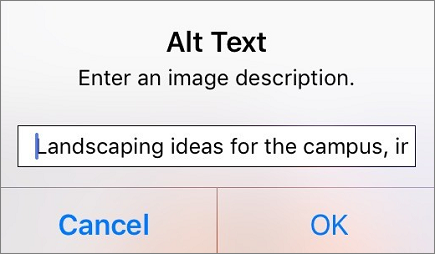
Add accessible hyperlink text
People who use screen readers sometimes scan a list of links. Links should convey clear and accurate information about the destination. For example, avoid using link texts such as "Click here," "See this page," "Go here," or "Learn more." Instead include the full title of the destination page.
Tip: If the title on the hyperlink's destination page gives an accurate summary of what’s on the page, use it for the hyperlink text. For example, this hyperlink text matches the title on the destination page: Create more with Microsoft templates.
-
In the email you are composing, select the piece of text where you want to insert the hyperlink.
-
If necessary, double-tap the selected text to open the context menu.
-
In the context menu, swipe left, and then select Add Link.
-
If you want to change the hyperlink text, type a new text to the Text field.
-
In the Link field, type or paste the destination URL.
-
To insert the hyperlink, select

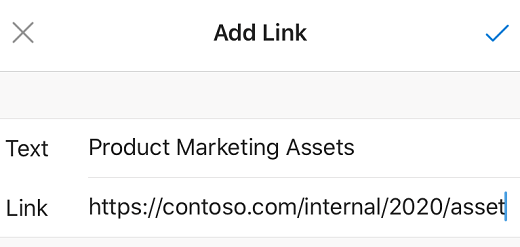
Create accessible lists
To make it easier for screen readers to read your email, organize the information in it into small chunks such as bulleted or numbered lists.
Design lists so that you do not need to add a plain paragraph without a bullet or number to the middle of a list. If your list is broken up by a plain paragraph, some screen readers might announce the number of list items wrong. Also, the user might hear in the middle of the list that they are leaving the list.
-
In the email message you're composing, place the cursor where you want to create a list.
-
In the toolbar above the on-screen keyboard, select

-
In the text formatting menu, select


-
Type the list item text, and then select return. A new list item is added. Repeat this step for each list item you want to add.
See also
Make your Word documents accessible to people with disabilities
Make your Excel documents accessible to people with disabilities
Make your PowerPoint presentations accessible to people with disabilities
Make your OneNote notebooks accessible to people with disabilities
In this topic
Best practices for making Outlook email accessible
The following table includes the key best practices for creating an Outlook for Android email that is accessible to people with disabilities.
|
What to fix |
Why fix it |
How to fix it |
|---|---|---|
|
Include alternative text with visuals. |
Alternative text helps people who can’t see the screen to understand what’s important in images and other visuals. |
|
|
Add meaningful hyperlink text. |
People who use screen readers sometimes scan a list of links. |
|
|
Use built-in lists. |
Organize and structure the information in your email into small units which are easy to read, navigate, and skim through. |
Add alternative text to visuals
Alt text helps people who can’t see the screen to understand what’s important in images, shapes, SmartArt graphics, charts, and other visuals. In alt text, briefly describe the image and mention its intent. Screen readers read the text to describe the image to users who can’t see the image.
Avoid using text in images as the sole method of conveying important information. If you must use an image with text in it, repeat that text in the email message.
To write a good alt text, make sure to convey the content and the purpose of the image in a concise and unambiguous manner. The alt text shouldn’t be longer than a short sentence or two—most of the time a few thoughtfully selected words will do. Do not repeat the surrounding textual content as alt text or use phrases referring to images, such as, "a graphic of" or "an image of."
For more info on how to write alt text, go to Everything you need to know to write effective alt text.
-
In the email you are composing, tap and hold an image to open the context menu.
-
In the context menu, select Alt text.
-
Type the alt text for the image.
Tip: Include the most important information in the first line and be as concise as possible.
-
When you're ready, select SAVE.
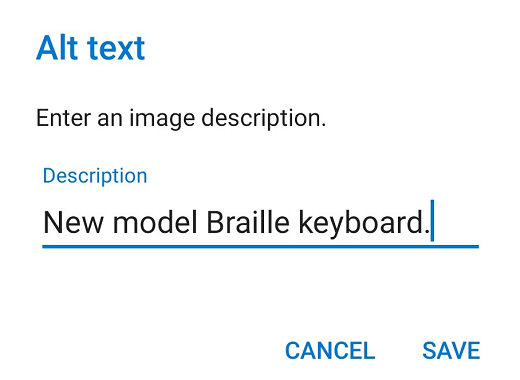
Add accessible hyperlink text
People who use screen readers sometimes scan a list of links. Links should convey clear and accurate information about the destination. For example, avoid using link texts such as "Click here," "See this page," "Go here," or "Learn more." Instead include the full title of the destination page.
Tip: If the title on the hyperlink's destination page gives an accurate summary of what’s on the page, use it for the hyperlink text. For example, this hyperlink text matches the title on the destination page: Create more with Microsoft templates.
-
In the email you are composing, select the piece of text where you want to add the hyperlink. The context menu opens.
-
In the context menu, select Add Link.
-
If you want to change the hyperlink text, type the new text to the Text to display text field.
-
In the Link text field, type or paste the destination URL.
-
To insert the hyperlink, select SAVE.
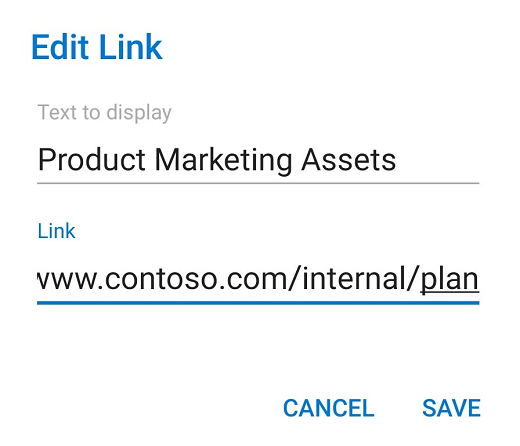
Create accessible lists
To make it easier for screen readers to read your email, organize the information in it into small chunks such as bulleted or numbered lists.
Design lists so that you do not need to add a plain paragraph without a bullet or number to the middle of a list. If your list is broken up by a plain paragraph, some screen readers might announce the number of list items wrong. Also, the user might hear in the middle of the list that they are leaving the list.
-
In the email message you're composing, place the cursor where you want to create a list.
-
In the toolbar above the on-screen keyboard, select

-
In the text formatting menu, select


-
Type the list item text, and then select

See also
Make your Word documents accessible to people with disabilities
Make your Excel documents accessible to people with disabilities
Make your PowerPoint presentations accessible to people with disabilities
Make your OneNote notebooks accessible to people with disabilities
In this topic
Best practices for making Outlook email accessible
The following table includes key best practices for creating Outlook on the web email that is accessible to people with disabilities.
|
What to fix |
Why fix it |
How to fix it |
|---|---|---|
|
Avoid common accessibility issues such as missing alternative text (alt text) and low contrast colors. |
Make it easy for everyone to read your email message. |
|
|
If you need to use tables, create a simple table structure for data only, and specify column header information. |
Screen readers keep track of their location in a table by counting table cells. |
|
|
Use built-in headings and styles. |
To make it easier for screen readers to read your email, use a logical heading order and the built-in formatting tools in Outlook. |
|
|
Include alternative text with all visuals. |
Alt text helps people who can’t see the screen to understand what’s important in images and other visuals. |
|
|
Add meaningful hyperlink text. |
People who use screen readers sometimes scan a list of links. |
|
|
Ensure that color is not the only means of conveying information. |
People who are blind, have low vision, or are colorblind might miss out on the meaning conveyed by particular colors. |
|
|
Use sufficient contrast for text and background colors. |
The text in your email should be readable in High Contrast mode so that everyone, including people with visual disabilities, can see it well. |
|
|
Use a larger font size (11pt or larger), sans serif fonts, and sufficient white space. |
People who have dyslexia describe seeing text “swim together” on a page (the compressing of one line of text into the line below). They often see text merge or distort. |
Check accessibility while you work in Outlook
The Accessibility Checker is a tool that reviews your content and flags accessibility issues it comes across. It explains why each issue might be a potential problem for someone with a disability. The Accessibility Checker also suggests how you can resolve the issues that appear.
To launch the Accessibility Checker, select Options > Check Accessibility or Message > Check Accessibility. The Accessibility checker pane opens, and you can now review and fix accessibility issues. For more info, go to Improve accessibility with the Accessibility Checker.
Avoid using tables
In general, avoid tables if possible and present the data another way, like paragraphs with headings and banners. Tables with fixed width might prove difficult to read for people who use Magnifier, because such tables force the content to a specific size. This makes the font very small, which forces Magnifier users to scroll horizontally especially on mobile devices.
If you have to use tables, use the following guidelines to make sure your table is as accessible as possible:
-
Avoid fixed width tables.
-
Make sure the tables render properly on all devices, including phones and tablets.
-
If you have hyperlinks in your table, edit the link texts, so they make sense and don't break mid-sentence.
-
Make sure the email is easily read with Magnifier. Send the email draft to yourself and view it on a mobile device to make sure people won’t need to horizontally scroll the email on a phone, for example.
Use table headers
Screen readers keep track of their location in a table by counting table cells. If a table is nested within another table or if a cell is merged or split, the screen reader loses count and can’t provide helpful information about the table after that point. Blank cells in a table could also mislead someone using a screen reader into thinking that there is nothing more in the table. Use a simple table structure for data only and specify column header information. Screen readers also use header information to identify rows and columns.
To ensure that tables don't contain split cells, merged cells, or nested tables, use the Accessibility Checker.
-
Place the cursor anywhere in a table.
-
On the Table tab, select Table options > Header row.
-
Type the column headers.
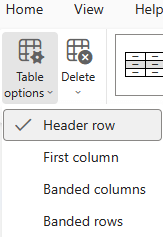
Use built-in headings and styles
Headings are meant to be scanned, both visually and with assistive technology. Ideally, headings explain what an email section is about. Use the built-in heading styles and create descriptive heading texts to make it easier for screen reader users to determine the structure of the message and navigate the headings.
Organize headings in the prescribed logical order and do not skip heading levels. For example, use Heading 1, Heading 2, and then Heading 3, rather than Heading 3, Heading 1, and then Heading 2. Organize the information in your document into small chunks. Ideally, each heading would include only a few paragraphs.
-
Select the piece of text you want to turn into a heading.
-
Select Message > Styles, and then pick the heading style you want, for example, Heading 1.
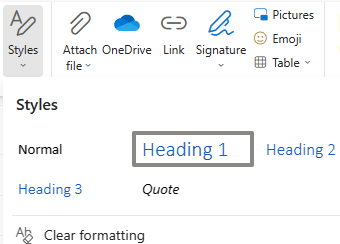
Add alt text to visuals
Alt text helps people who can’t see the screen to understand what’s important in visual content. Visual content includes pictures, SmartArt graphics, shapes, groups, charts, embedded objects, ink, and videos. In alt text, briefly describe the image and mention its intent. Screen readers read the text to describe the image to users who can’t see the image.
Avoid using text in images as the sole method of conveying important information. If you must use an image with text in it, repeat that text in the document. In alt text, briefly describe the image and mention the existence of the text and its intent.
To write a good alt text, make sure to convey the content and the purpose of the image in a concise and unambiguous manner. The alt text shouldn’t be longer than a short sentence or two—most of the time a few thoughtfully selected words will do. Do not repeat the surrounding textual content as alt text or use phrases referring to images, such as, "a graphic of" or "an image of." For more info on how to write alt text, go to Everything you need to know to write effective alt text.
To find missing alt text, use the Accessibility Checker.
-
When you're composing an email, right-click an image in the message body. The context menu opens.
-
In the context menu, select Add alternate text.
-
Type the alt text for the image, and then select OK.
Use accessible hyperlink texts
People who use screen readers sometimes scan a list of links. Links should convey clear and accurate information about the destination. For example, avoid using link texts such as "Click here," "See this page," "Go here," or "Learn more." Instead include the full title of the destination page.
Tip: If the title on the hyperlink's destination page gives an accurate summary of what’s on the page, use it for the hyperlink text. For example, this hyperlink text matches the title on the destination page: Create more with Microsoft templates.
-
When you're composing an email, type a meaningful link text in the message body.
-
Select the link text, and then press Ctrl+K. The Insert link dialog box opens.
-
If you want to change the link text, type a new text to the Display as text field.
-
In the Web address (URL) text field, type or paste the destination URL.
-
When you're ready, select OK.
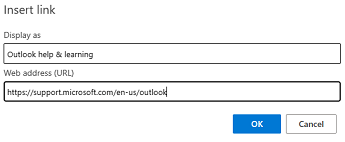
Turn off link preview
When you add a URL to an email in Outlook.com or Outlook on the web, or when you receive an email with a URL in the body, you'll see a rich text preview that includes a link title, thumbnail image, and description of the link. This is called a link preview and it is turned on by default.
To reduce clutter and distractions, you can turn off link preview.
-
Select (Settings). The Settings window opens.
-
In the Settings window, select Mail > Compose and reply.
-
Under Link preview, clear the Preview links in email checkbox to turn off link preview.
Use accessible font format and color
An accessible font doesn't exclude or slow down the reading speed of anyone reading an email message, including people with low vision or reading disability or people who are blind. The right font improves the legibility and readability of the email messages.
Use accessible font format
To reduce the reading load, select familiar sans serif fonts such as Arial or Calibri, and use a large enough font size (11pt or larger). Avoid using all capital letters and excessive italics or underlines.
A person with a vision disability might miss out on the meaning conveyed by particular colors. For example, add an underline to color-coded hyperlink text so that people who are colorblind know that the text is linked even if they can’t see the color.
-
Select the piece of text you want to format.
-
To change the font type, expand the font menu on the ribbon, and then select the font type you want.
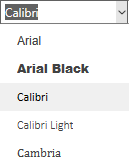
-
To change the font size, expand the font size menu on the ribbon, and then select the size you want.

Use accessible font color
The text in your email should be readable in a high contrast mode. For example, use bright colors or high-contrast color schemes on opposite ends of the color spectrum. White and black schemes make it easier for people who are colorblind to distinguish text and shapes.
To find insufficient color contrast, use the Accessibility Checker.
-
Select the piece of text you want to format.
-
On the ribbon, select

-
In the Font color menu, select the color you want.
Create accessible lists
To make it easier for screen readers to read your email message, organize the information in it into small chunks such as bulleted or numbered lists.
Design lists so that you do not need to add a plain paragraph without a bullet or number to the middle of a list. If your list is broken up by a plain paragraph, some screen readers might announce the number of list items wrong. Also, the user might hear in the middle of the list that they are leaving the list.
-
In your email, place the cursor where you want to create a list.
-
On the ribbon, select


-
Type each list item in the bulleted or numbered list.
Use accessible text alignment and spacing
People with dyslexia perceive text in a way that can make it difficult to distinguish letters and words. For example, they might perceive a line of text compressing into the line below, or adjacent letters seeming to merge. Also, having multiple blank lines or consecutive spaces can make keyboard navigation slow and screen reader usage more cumbersome.
Align your paragraph to the left to avoid uneven gaps between words, and increase or decrease the white space between lines to improve readability. Include sufficient white space between lines and paragraphs but avoid more than two spaces between words and two blank lines between paragraphs.
-
In your email, place the cursor within the paragraph whose text alignment you want to adjust.
-
On the ribbon, select

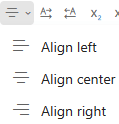
Request accessible email
Let people who send you email know that you prefer to receive accessible content.
-
In Outlook on the web, select (Settings). The Settings window opens.
-
In the Settings window, select General > Accessibility.
-
To request accessible content, select the Ask senders to send content that’s accessible checkbox. Then close the Settings window.
Test the accessibility of your email message
When your email is ready, you can try a couple of things to make sure the email is accessible:
-
Run the Accessibility Checker. For instructions, go to Check accessibility while you work in Outlook or Improve accessibility with the Accessibility Checker.
-
Try navigating and reading the email using the built-in screen reader, Narrator. Narrator comes with Windows, so there's no need to install anything. This is one additional way to spot issues in the navigation order, for example.
-
To turn on Narrator, press Windows logo key+Ctrl+Enter.
-
To navigate the content in the message, use the arrow keys. Modify the reading order of the elements in the email if necessary.
To have Narrator read the whole email window, press the Narrator key (Caps lock or Insert)+W.
For more info on how to navigate with Narrator, go to Chapter 3: Using scan mode, Chapter 4: Reading text, or Chapter 5: Navigation.
-
To turn off Narrator, press Windows logo key+Ctrl+Enter.
-
See also
Improve accessibility with the Accessibility Checker
Rules for the Accessibility Checker
Make your Word documents accessible to people with disabilities
Make your Excel documents accessible to people with disabilities
Make your PowerPoint presentations accessible to people with disabilities
Make your OneNote notebooks accessible to people with disabilities
Technical support for customers with disabilities
Microsoft wants to provide the best possible experience for all our customers. If you have a disability or questions related to accessibility, please contact the Microsoft Disability Answer Desk for technical assistance. The Disability Answer Desk support team is trained in using many popular assistive technologies and can offer assistance in English, Spanish, French, and American Sign Language. Please go to the Microsoft Disability Answer Desk site to find out the contact details for your region.
If you are a government, commercial, or enterprise user, please contact the enterprise Disability Answer Desk.











